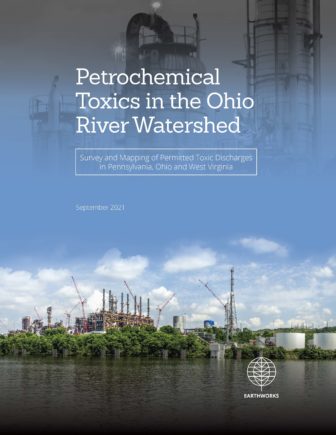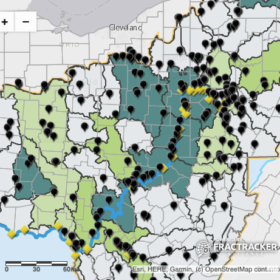
Before further expansion of the petrochemical industry occurs in the Ohio River Basin, it is important to understand the industry’s current footprint and how much toxic pollution is currently discharged into the Basin’s streams and rivers. Earthworks’ report, Petrochemical Toxics in the Ohio River Watershed, released September 2021 analyzed data on NPDES permits to understand the petrochemical industry’s current footprint in the upper Ohio River Basin. Commissioned by Earthworks, the analysis was done in partnership with FracTracker Alliance and Ryan Talbott.

While the Shell petrochemical complex in Monaca, Pennsylvania will be one of the largest polluters, it is not the only petrochemical facility permitted to pollute the Ohio River. There are already dozens of petrochemical facilities in the Ohio River Basin which, along with Shell, are permitted to pollute over 500,000 pounds of toxic pollutants in Pennsylvania, Ohio, and West Virginia annually. Out of these facilities, just two dozen are responsible for nearly 80% of the total annual toxic discharge.
For decades communities in the Ohio River Valley have sacrificed their health, environment, and economic prosperity for the fossil fuel industry. Once again, our communities are being sacrificed, this time for plastic. The petrochemical buildout of the Ohio River Valley would substantially increase the amount of toxic discharge into our rivers and streams but this report only accounts for permitted pollution. It is clear that the solution can not be tighter regulation but instead must be simply not issuing the permits at all. The Ohio River is already considered one of the most polluted rivers in the country – regulators should be working to clean it up – not allow it to be polluted further.
Your Support Makes Our Work Possible
Earthworks helps families on the front lines of mining, drilling, and fracking. We use sound science to expose health, environmental, economic, social, and cultural impacts of mining and energy extraction. To support our efforts, please consider a tax-deductible donation today that will go toward our work reforming government policies, improving corporate practices, influencing investment decisions, and encouraging responsible materials sourcing and consumption.

